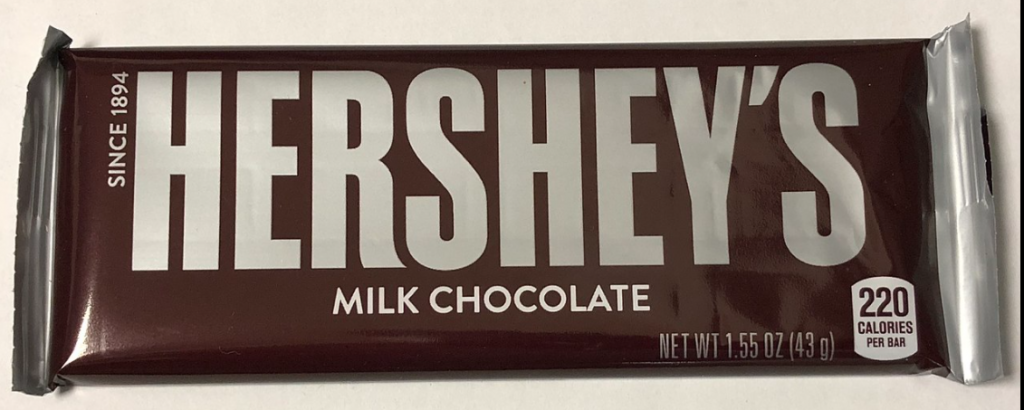Why You Probably Prefer European Chocolate

Pictured above is a Hershey’s Milk Chocolate bar. As the label proudly states, the Hershey bar was available for your enjoyment in 1894, which is mostly true; while Lancaster County, Pennslyvania native Milton Hershey introduced his first chocolate bar that year, he didn’t name it the Hershey bar we now know until November of 1900. And since then, the name “Hershey” has been synonymous with his delightful chocolate treats.
Unless you’re European. In that case, if you’ve had a Hershey bar, you probably don’t think of it as a delight. At best, a Hershey bar is a sub-par treat; at worst, it’s gross. Americans probably think you’re overreacting — how can a whole continent of people find a world-famous chocolate bar revolting?
Blame baby vomit.
Kind of.
In the mid-1880s, Milton Hershey was a successful confectioner; chocolate wasn’t even yet in his repertoire. But during a trip to the Chicago World’s Fair in 1893, he discovered the rich, elegant taste of German chocolate and realized he needed to add it to his offerings. Over the next few months, he developed a candy bar of his own, and soon, it became more popular than most (if not all) of his other products. With European chocolate still unknown to the American masses, the Hershey bar became the iconic definition or what a chocolate bar should taste like throughout the United States.
But there were — and still are — definite differences between Hershey’s chocolate and the stuff you’ll find from Germany, Switzerland, and the rest of Europe. That’s because when Milton Hershey went to copy the success of his German predecessors, he didn’t do so using the same methods. The actual process for making a Hershey bar is a trade secret, but as the New York Times explains, “experts speculate that Hershey’s puts its milk through controlled lipolysis, a process by which the fatty acids in the milk begin to break down.” This creates something called butyric acid which, the Times continues, is “also found in Parmesan cheese and the spit-up of babies [yes, baby vomit].” And that’s something you typically wouldn’t want in your 220-calorie treat.
Most American consumers, though, didn’t know better. The butyric acid doesn’t overwhelm the chocolate’s flavor; it just gives it a tangy taste. And as most Americans at the time had never tasted chocolate without butyric acid, they didn’t know that chocolate didn’t have to taste that way. Further, the process that created the butyric acid helped Hershey bars spread throughout the continent; as Chedder explains, “with Hershey’s new process, chocolate could live on shelves for up to a year.” Americans, as a result, came to expect chocolate bars to taste the way Hershey bars tasted, baby puke and all.
So, other American chocolatiers got in on the act. Per the above-linked Times article, in order to meet consumer expectations, “other [American] chocolate manufacturers now simply add butyric acid to their milk chocolates.” For those of us living in the United States, it’s therefore very hard to find an American-made chocolate bar that doesn’t have Hershey’s formerly distinctive aftertaste. And for those of us more accustomed to European chocolate, it makes sense that Hershey’s tastes kind of like vomit, because it kind of does.
Bonus fact: As noted above, the Hershey Company — makers of chocolate bars — was founded in Lancaster County, Pennsylvania, in 1894. Confusingly, the Hershey Creamery Company — makers of ice cream — was also founded in Lancaster County, Pennsylvania, in 1894. But as the word “confusingly” should have already made clear, the two companies aren’t related. The ice cream company was founded by four brothers whose last name was Hershey, but who were not related to Milton in any meaningful way. (Given the fact that they had the same name and live in the same general area, there’s a good chance they were like, fourth-degree cousins or something like that.) The two sides have been engaged in on-again, off-again litigation for about a century; Here’s a case from 1967 and here’s another from 1991, and you’ll note that the 1991 decision states that “in 1921, Hershey Chocolate filed the first lawsuit between these parties in the Middle District of Pennsylvania.” Today, the ice cream company’s website notes that it is “not affiliated with Hershey’s chocolate” at the bottom of its homepage; the chocolate company does not return the favor.
From the Archives: The Wartime Chocolate Bar You Don’t Want to Eat: A Hershey bar that intentionally tasted bad.
